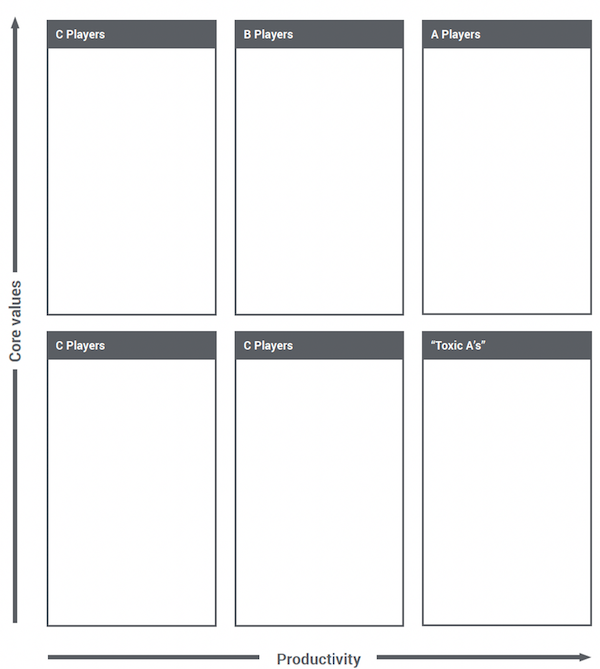Quick Summary
Tolerating toxic A-Players can erode team morale and productivity, as negative behaviours are significantly more influential than positive ones. Leaders should confront toxic behaviors directly, align actions with core company values, and, if necessary, part ways with these team members to preserve a healthy work environment.
Takeaways
- Despite high performance toxic A-players can damage team morale and company culture.
- Leaders must address toxic behaviors early to prevent long-term harm.
- Upholding core company values should take priority over individual performance.
- If necessary, removing toxic employees is essential to maintaining a healthy, productive workplace.
Picture this: Christmas in an M&S warehouse, and a group of graduates has been brought in to help with the festive rush. Excited and ready to make a difference, they gather to hear the Warehouse Manager’s welcome. Here’s what he says:
“If you work too hard, you’re getting sacked. I don’t want any of you making the regulars look bad.”
That manager’s words have stayed with me ever since. One of those graduates, standing there, was me.
This wasn’t just a poor choice of words; it was a toxic mindset. This manager was responsible for the warehouse in a branch turning over nearly £100 million, yet he led with negativity and mediocrity. He didn’t want to inspire or encourage excellence—he wanted to protect the status quo, even if it meant discouraging new talent.
He was the perfect example of a “Toxic A-Player.” His numbers might have looked good, but his attitude corroded the culture, stifling ambition and dragging down performance.
The lesson was clear: a single toxic leader can contaminate an entire firm. And if you allow that to fester, it’s not just people who suffer—it’s the whole organisation.
What is a ‘Toxic A-Player’ Anyway?
According to Brad Smart, the guy behind Topgrading, an A-Player is in the top 10% for their role, salary, and location. In other words, the rockstars who would get hired again in a heartbeat. But every now and then, you find yourself with an A-Player who is also a toxic tornado. They perform well but don’t fit your company’s values, and they’re the kind of person everyone dreads working with.
You know the type: top performer on paper, but they leave a trail of tension, resentment, or outright dread in their wake. It’s that genius coder who can’t stand their team or the high-performing salesperson who bulldozes morale. These are your Toxic A-Players. Sure, they’re great at what they do, but the negativity they bring can spread through your team faster than you can say “toxic workplace.”
The High Cost of Ignoring Toxicity
A lot of companies shy away from dealing with these toxic types because they’re seen as irreplaceable. But here’s a truth you need to accept: your culture is shaped by the worst behaviour you let slide. So if you keep letting your Toxic A-Players run the show, don’t be surprised when their behaviour starts spreading.
Think your other employees aren’t noticing? They are, and they’re wondering why these people get a free pass. Soon enough, they’ll start asking if this is the kind of place they want to stick around in.
Negativity’s Outsize Impact on Team Performance

I’ve written before about the negativity bias—the brain’s unfortunate tendency to react more strongly to negative actions or comments. Research shows that negative behaviours are four to five times more impactful than positive ones. This is crucial to remember when deciding how to handle your Toxic A-Player.
Will Felps, a researcher at the University of Washington, explored this concept in a fascinating experiment on team dynamics. He divided college students into teams of four to compete in solving management challenges, with cash prizes as motivation. What the participants didn’t know was that Felps had planted an actor in some of the teams, instructed to embody one of three problematic personality types often found in the workplace:
- The Depressive Pessimist – constantly complains about the work and sows doubt in the group’s ability to succeed.
- The Jerk – criticises others’ ideas without offering any constructive input.
- The Slacker – exhibits a “whatever” attitude, signalling that they simply don’t care.
Felps initially believed that the rest of the team could counteract the negative influence of one “bad apple.” Instead, he found the opposite. Teams with a toxic member performed 30–40% worse than those without, unable to overcome the corrosive effects of negativity.
The takeaway? Toxic behaviour doesn’t just affect morale; it undermines performance. And the more you tolerate it, the more you risk dragging the entire team down. The ability to get on with each other, share work and collaborate dropped like a stone. Worse, the groups with the negative team member started to take on their behaviour. The actor was the biggest predictor of team performance. There’s truth in that time-honoured cliché – a bad apple really can spoil the whole barrel.
Time to Confront the Problem
Now is the perfect time to confront and deal with toxic staff in your organisation. Assess all your employees against the following criteria:
Ask yourself, would you enthusiastically re-hire each of these people? If not, plan now how you’re going to deal with your C-Players and your toxic A-Players. Don’t carry them into next year. Netflix calls this the ‘keeper test’. If they resigned, would you fight to keep them?

It’s vital to confront negative behaviours, discuss them and ask them to stop. Sit them in a room and make it crystal clear that you’re not going to put up with their negativity or poor attitude anymore. As mentioned earlier, get really specific. Check that it isn’t your remuneration system that’s driving the toxic behaviour. If it is, fix it. Then give your Toxic A-Player an option to change. If they can’t, even if you perceive they’re going to be difficult to replace, they’ve got to go. It will be impossible for you to drive the cultural change you need if there’s a boat anchor dragging on the bottom.
This sends a clear message to other staff and ensures the ‘fence-sitters’ get off the fence. Every time I’ve got rid of a Toxic A, the whole organisation heaves a sigh of relief, if not doing a little victory dance. It’s obvious to everyone. Suddenly the tension drops out of the business and you start to move forward again. People say, ‘I can’t believe you didn’t get rid of that jerk quicker’.
Good Managers Are Key
Interestingly, Felps’ experiment did reveal a glimmer of hope: one team with a “bad apple” still thrived, thanks to effective leadership. This underscores a crucial insight backed by Gallup research—85% of team engagement is driven by interactions with their manager. Identifying these standout managers is essential; they’re the ones who can neutralise negativity and uplift team performance.
Our go-to tool for this? Friday Pulse. It’s ideal for tracking team happiness on a weekly basis, giving you a clear, ongoing read on team morale. Not only can you use it to gauge overall sentiment, but you can also stack rank your managers, quickly identifying the ones driving engagement and resilience.
Pairing this with a quarterly talent assessment (every 90 days, minimum) offers a full view of your team dynamics and flags any emerging issues. It’s a proactive approach—one that lets you address toxic influences early, before they can undermine the team.
Use Core Values to Set a New Standard

Your core values are meaningless if they aren’t guiding how you hire, fire, and promote. Values should make clear the behaviours expected from every team member. Without this clarity, you lack the framework for tough conversations, and by allowing toxic behaviours to slip through, you’re effectively endorsing them. Left unchecked, these behaviours can become the standard, and soon, everyone in your company knows it.
Implementing a behavioural framework can help turn the tide. This gives you and your managers a shared language to call out negative, destructive behaviours and make it clear that they’re no longer tolerated. When communicated well, this framework also signals to toxic team members that their conduct is under scrutiny.
With this structure, managers can be specific in performance discussions, tying feedback directly back to core values and pointing to concrete examples of poor behaviour. Setting timelines for improvement, with regular check-ins, creates accountability and ensures issues are addressed decisively.
Written by business coach and leadership coaching expert Dominic Monkhouse. Contact him to schedule a call here. You can order your free copy of his book, Mind Your F**king Business here.

